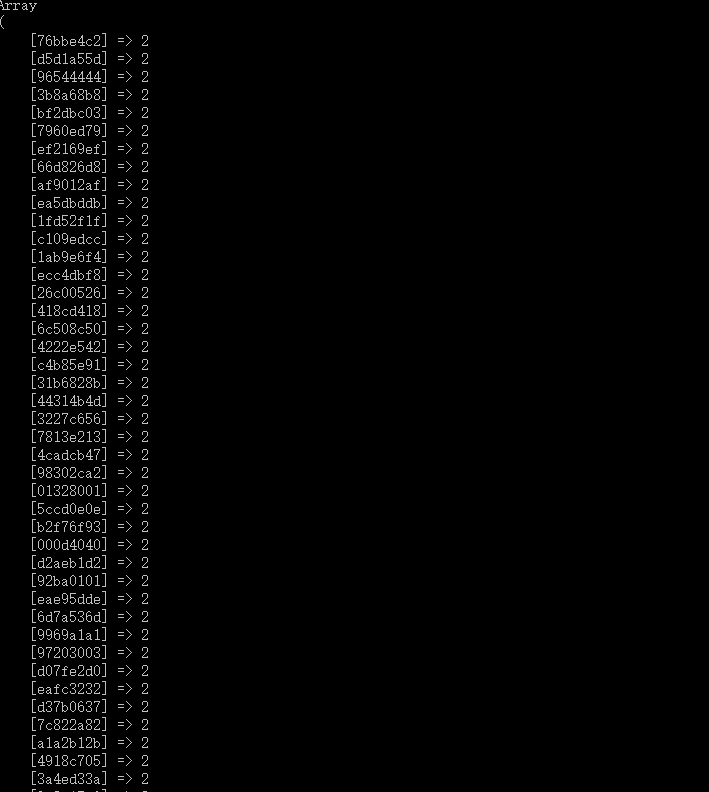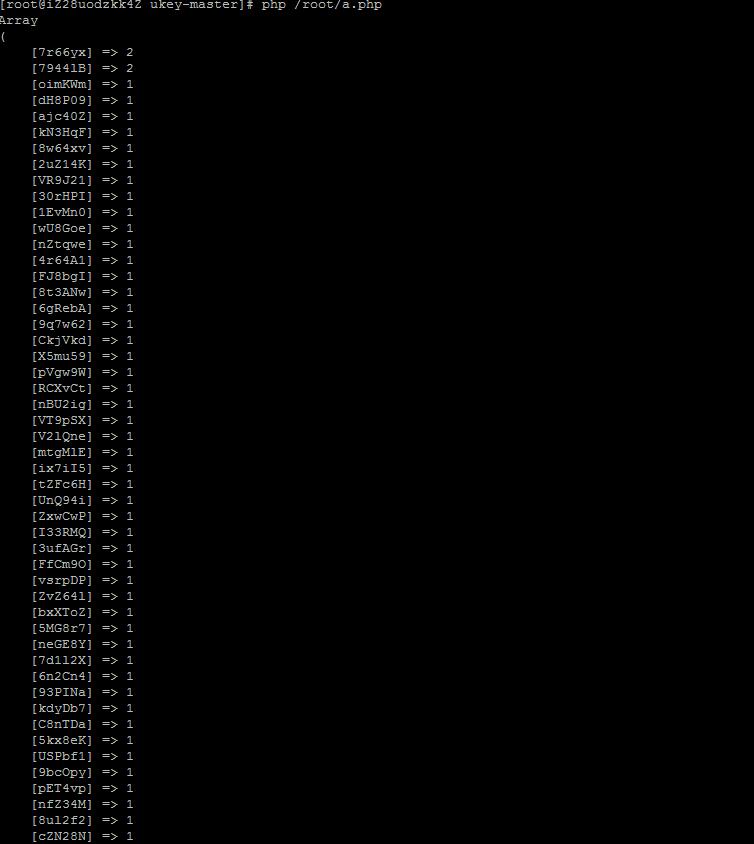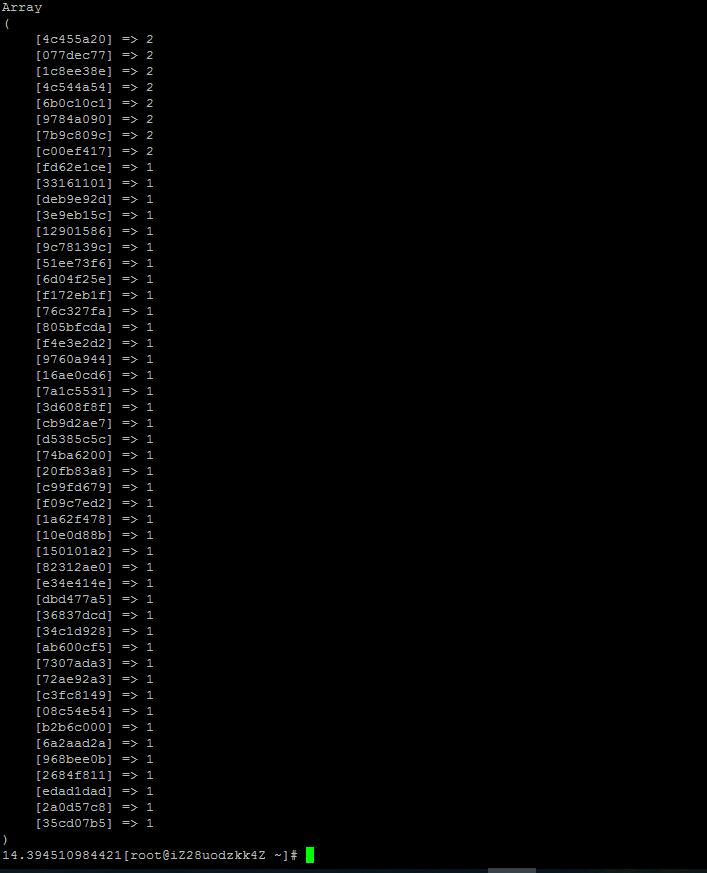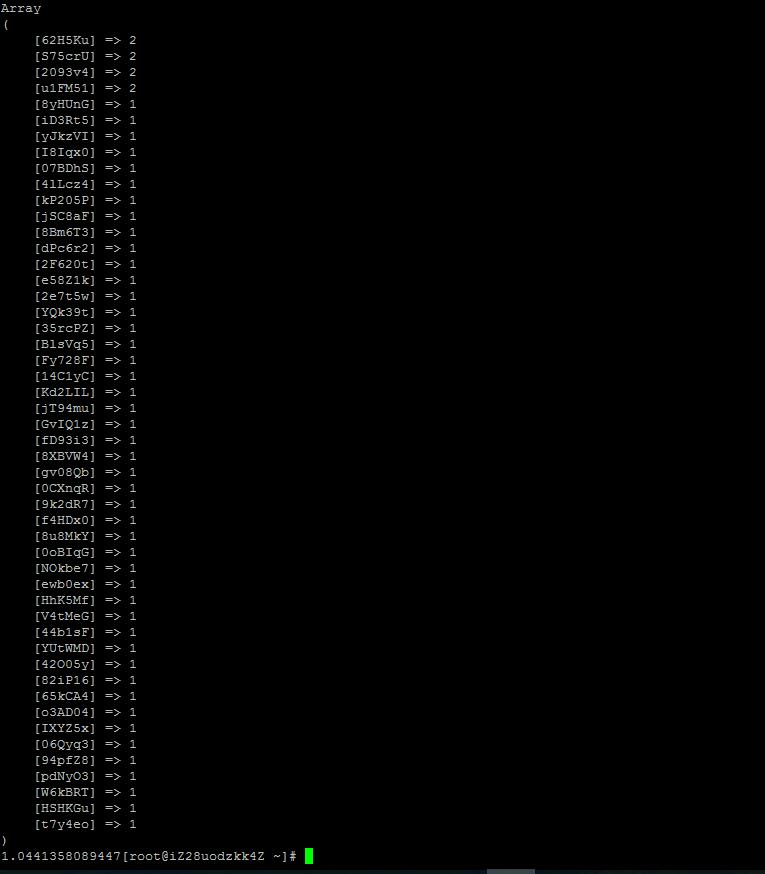由于要用到固定长度的随机字符串。
首先是一段PHP代码
$str_md5=md5(uniqid()); $rand = mt_rand(1, 28); $str1=substr($str_md5,$rand,6); $rand = mt_rand(1, 28); $str2=substr($str_md5,$rand,6); $rand = mt_rand(1, 28); $str3=substr($str_md5,$rand,6); $code=substr($str1.$str2.$str3,0,8);

生成180000个随机字符串,图中是按照重复数量倒序排列,可以看到基本都有重复的。不过也是比较理想的。
由于想提升一下自己的C语言能力,所以用C重新写了一下随机生成字符串。
其中用到了随机数函数srand(),rand();
不过折腾一两个小时,随机数还是有问题。并发访问时时间可能几乎为同时,那么srand给的种子时间可以视为相同的。这样就导致了,产生的随机数也是一样的。从而产生的随机字符串也是一样的。循环输出随机字符串,几乎都是一模一样的。
后来想到了ukey,这个扩展可以实现唯一的ID,那么访问都产生唯一的ID,是不是可以将这个ID作为种子时间。答案是肯定的。

上图是产生的随机字符串,可以自定义长度。也同样可以输出只有数字的字符串。相较PHP所产生的随机字符串重复率更低且速度更快。
PHP_FUNCTION(get_random__num_str)
{
int length=8;
if (zend_parse_parameters(ZEND_NUM_ARGS() TSRMLS_CC, "l", &length) == FAILURE)
{
length=8;
}
length++;
int flag, i;
char* string; __uint64_t timestamp = realtime();
__uint64_t retval;
int len;
char buf[128];
if (timestamp == 0ULL) {
RETURN_FALSE;
}
spin_lock(lock, pid);
if (context->last_timestamp == timestamp) {
context->sequence = (context->sequence + 1) & context->sequence_mask;
if (context->sequence == 0) {
timestamp = skip_next_millis();
}
} else {
context->sequence = 0; /* Back to zero */ }
context->last_timestamp = timestamp;
retval = ((timestamp - context->twepoch) << context->timestamp_left_shift)
| (context->datacenter_id << context->datacenter_id_shift)
| (worker_id << context->worker_id_shift)
| context->sequence;
spin_unlock(lock, pid); //printf('%ld',retval);
srand((unsigned)retval);
//srand((unsigned) time(NULL )); if ((string = (char*) emalloc(length)) == NULL )
{
//myLog("Malloc failed!flag:14\n"); RETURN_NULL() ;
}
for (i = 0; i < length - 1; i++)
{
flag = rand() % 3;
switch (flag)
{ case 0: string[i] = '1' + rand() % 5; break; case 1: string[i] = '2' + rand() % 7; break; case 2: string[i] = '0' + rand() % 10; break; default: string[i] = '9'; break;
}
}
string[length - 1] = '\0';
RETURN_STRINGL(string,length,0);
}
PHP_FUNCTION(get_random_str)
{
int length=8;
if (zend_parse_parameters(ZEND_NUM_ARGS() TSRMLS_CC, "l", &length) == FAILURE)
{
length=8;
}
length++;
int flag, i;
char* string; __uint64_t timestamp = realtime();
__uint64_t retval;
int len;
char buf[128];
if (timestamp == 0ULL) {
RETURN_FALSE;
}
spin_lock(lock, pid);
if (context->last_timestamp == timestamp) {
context->sequence = (context->sequence + 1) & context->sequence_mask;
if (context->sequence == 0) {
timestamp = skip_next_millis();
}
} else {
context->sequence = 0; /* Back to zero */ }
context->last_timestamp = timestamp;
retval = ((timestamp - context->twepoch) << context->timestamp_left_shift)
| (context->datacenter_id << context->datacenter_id_shift)
| (worker_id << context->worker_id_shift)
| context->sequence;
spin_unlock(lock, pid); //printf('%ld',retval);
srand((unsigned)retval);
//srand((unsigned) time(NULL )); if ((string = (char*) emalloc(length)) == NULL )
{
//myLog("Malloc failed!flag:14\n"); RETURN_NULL() ;
}
for (i = 0; i < length - 1; i++)
{
flag = rand() % 3;
switch (flag)
{ case 0: string[i] = 'A' + rand() % 26; break; case 1: string[i] = 'a' + rand() % 26; break; case 2: string[i] = '0' + rand() % 10; break; default: string[i] = 'x'; break;
}
}
string[length - 1] = '\0';
RETURN_STRINGL(string,length,0);
}
上图是PHP生成18W随机字符串所用的时间

上图是C扩展生成18W随机字符串所用的时间
所用的服务器都是1G内存 双核的阿里云服务器。
只要在ukey中加入上如代码就可以生产随机字符串和随机长度数字字符串
ukey的地址http://www.oschina.net/p/ukey




